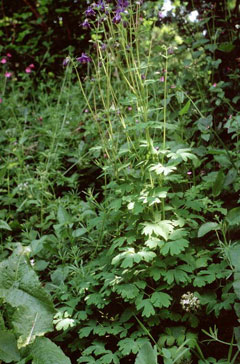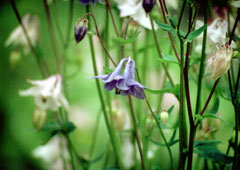 |
|
http://commons.wikimedia.org/wiki/File:Aquilegia_vulgaris.jpg |
 |
| (c) 2010 Ken Fern & Plants For A Future |
Translate this page:
Summary
Bloom Color: Blue, Pink, Purple, Red, White. Main Bloom Time: Late spring.Form: Upright or erect.
Physical Characteristics

 Aquilegia vulgaris is a PERENNIAL growing to 1 m (3ft 3in) by 0.5 m (1ft 8in) at a medium rate.
Aquilegia vulgaris is a PERENNIAL growing to 1 m (3ft 3in) by 0.5 m (1ft 8in) at a medium rate.
See above for USDA hardiness. It is hardy to UK zone 4 and is not frost tender. It is in flower from April to July, and the seeds ripen from July to August. The species is hermaphrodite (has both male and female organs) and is pollinated by Bees.
Suitable for: light (sandy) and medium (loamy) soils and prefers well-drained soil. Suitable pH: mildly acid, neutral and basic (mildly alkaline) soils. It can grow in semi-shade (light woodland) or no shade. It prefers moist soil.
UK Hardiness Map
US Hardiness Map
Synonyms
Plant Habitats
Woodland Garden Sunny Edge; Dappled Shade; Shady Edge;
Edible Uses
Edible Parts: Flowers
Edible Uses: Tea
Flowers - raw. Rich in nectar, they are sweet and delightful[172], they make a very attractive addition to mixed salads and can also be used as a thirst-quenching munch in the garden[K]. The flowers are also used as a tea substitute[177].
References More on Edible Uses
Medicinal Uses
Plants For A Future can not take any responsibility for any adverse effects from the use of plants. Always seek advice from a professional before using a plant medicinally.
Antianxiety Astringent Depurative Diaphoretic Diuretic Homeopathy Parasiticide Parasiticide
Columbine was formerly employed in herbal medicine mainly for its antiscorbutic effect, but it has fallen out of favour and is little used nowadays[268]. The leaves root and seed are astringent, depurative, diaphoretic, diuretic, parasiticide[4, 7, 9, 19, 21]. Because of its toxic properties, this plant should not be taken internally without expert advice, though the root is sometimes used externally in poultices to treat ulcers and the commoner skin diseases[7, 268]. The plant can be harvested at any time from June to October[7]. Columbine has produced very unsatisfactory results and is not normally used medicinally[4]. A homeopathic remedy is made from the plant[7]. It is used in the treatment of affections of the nervous system[7].
References More on Medicinal Uses
The Bookshop: Edible Plant Books
Our Latest books on Perennial Plants For Food Forests and Permaculture Gardens in paperback or digital formats.

Edible Tropical Plants
Food Forest Plants for Hotter Conditions: 250+ Plants For Tropical Food Forests & Permaculture Gardens.
More

Edible Temperate Plants
Plants for Your Food Forest: 500 Plants for Temperate Food Forests & Permaculture Gardens.
More

More Books
PFAF have eight books available in paperback and digital formats. Browse the shop for more information.
Shop Now
Other Uses
References More on Other Uses
Cultivation details
Landscape Uses:Border, Rock garden, Woodland garden. Succeeds in ordinary garden soil, preferring a moist but not wet soil and a sunny position[1]. Thrives in partial shade[1, 111]. Intolerant of heavy clay[200]. Plants are hardy to at least -25°c[187]. Whilst the blue-flowered forms of this species have no scent, white flowered forms have a soft clove scent in order to attract pollinating insects[245]. Most species are short-lived, dying out after 2 - 3 years, though they usually produce seed prolifically[200]. This species usually self-sows freely in the garden, it is very apt to hybridize with other members of the genus and usually becomes the dominant partner in any hybridization[200]. Plants seem to be immune to the predations of rabbits[233]. A greedy plant, inhibiting the growth of nearby plants, especially legumes[54, 201]. It also attracts red spider mites to the garden, these can then move on to other crops such as apples, pears and strawberries[201]. It grows well with rhubarb[201]. Special Features:Attracts birds, Not North American native, Naturalizing, All or parts of this plant are poisonous, Suitable for cut flowers. In garden design, as well as the above-ground architecture of a plant, root structure considerations help in choosing plants that work together for their optimal soil requirements including nutrients and water. The root pattern is fibrous dividing into a large number of fine roots [2-1].
References Carbon Farming Information and Carbon Sequestration Information
Temperature Converter
Type a value in the Celsius field to convert the value to Fahrenheit:
Fahrenheit:
The PFAF Bookshop
Plants For A Future have a number of books available in paperback and digital form. Book titles include Edible Plants, Edible Perennials, Edible Trees,Edible Shrubs, Woodland Gardening, and Temperate Food Forest Plants. Our new book is Food Forest Plants For Hotter Conditions (Tropical and Sub-Tropical).
Shop Now
Plant Propagation
Seed - best sown as soon as it is ripe in a cold frame. The seed can be slow to germinate[200]. Stored seed can be sown in late winter in a cold frame. When large enough to handle, prick the seedlings out into individual pots and grow them on in a cold frame for their first winter. Plant out in late spring or early summer. Division in spring[200].
Other Names
If available other names are mentioned here
Native Range
EUROPE: United Kingdom, Ireland, Austria, Belgium, Switzerland, Czech Republic, Germany, Hungary, Netherlands, Poland, Slovakia, Russian Federation-European part (European part (west)), Belarus, Estonia, Lithuania, Latvia, Ukraine (west), Albania, Bosnia and Herzegovina, Greece, Croatia, Italy (incl. Sicily), North Macedonia, Montenegro, Serbia, Slovenia, Spain, France (incl. Corsica), Portugal AFRICA: Algeria, Morocco
Weed Potential
Right plant wrong place. We are currently updating this section.
Please note that a plant may be invasive in one area but may not in your area so it's worth checking.
Conservation Status
IUCN Red List of Threatened Plants Status :

Growth: S = slow M = medium F = fast. Soil: L = light (sandy) M = medium H = heavy (clay). pH: A = acid N = neutral B = basic (alkaline). Shade: F = full shade S = semi-shade N = no shade. Moisture: D = dry M = Moist We = wet Wa = water.
Now available:
Food Forest Plants for Mediterranean Conditions
350+ Perennial Plants For Mediterranean and Drier Food Forests and Permaculture Gardens.
[Paperback and eBook]
This is the third in Plants For A Future's series of plant guides for food forests tailored to
specific climate zones. Following volumes on temperate and tropical ecosystems, this book focuses
on species suited to Mediterranean conditions—regions with hot, dry summers and cool, wet winters,
often facing the added challenge of climate change.
Read More
Expert comment
Author
L.
Botanical References
17200
Links / References
For a list of references used on this page please go here
Readers comment
| Add a comment |
|
If you have important information about this plant that may help other users please add a comment or link below. Only comments or links that are felt to be directly relevant to a plant will be included. If you think a comment/link or information contained on this page is inaccurate or misleading we would welcome your feedback at [email protected]. If you have questions about a plant please use the Forum on this website as we do not have the resources to answer questions ourselves.
* Please note: the comments by website users are not necessarily those held by PFAF and may give misleading or inaccurate information.
To leave a comment please Register or login here All comments need to be approved so will not appear immediately.
|
Subject : Aquilegia vulgaris
|
|
|
|